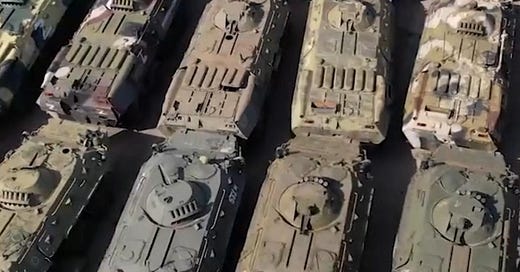Simple and Available, the Wheeled BTR-82 Is the Russian Military's Vehicular Future
Russian industry is generating enough BTR-82s to make good losses and equip new units
In preparation for a renewed push against the Ukrainian salient in western Russia’s Kursk Oblast last week, the Kremlin reportedly delivered to the Russian navy’s 810th Naval Infantry Brigade—holding positions just north of the 270-square-mile salient, which a powerful Ukrainian force captured in August—a batch of 40 factory-fresh BTR-82 wheeled infantry fighting vehicles.
And not for no reason. Russian industry is struggling to generate enough tanks and tracked BMP fighting vehicles to fully make good Russia’s deepening losses in its 33-month wider war on Ukraine. But it’s either not struggling, or—more likely—struggling much less to generation the comparatively simpler BTRs.
In other words, expect to see more of the 17-ton IFVs along the front line in Russia and Ukraine as Russia’s yearlong offensive grinds on—and Russian losses demand more and more of the country’s combat vehicle industry.
The BTR-82 is an upgraded version of the 1980s-vintage BTR-80 with improved armor, modern night vision, satellite navigation and a more powerful 300-horsepower engine replacing the original 240-horsepower model. A BTR-80/82 has a crew of three and room for seven passengers. The BTR-82 comes armed with a 30-millimeter autocannon that some have criticized for a lack of accuracy compared to Western autocannons.
The Russian army went to war in February 2022 with 1,500 BTR-80s; the navy had another 100 of the vehicles. Since then, analysts have tallied around 1,300 destroyed, damaged and abandoned BTR-80s and BTR-82s.
The Royal United Services Institute in London tried to get a handle on BTR-82 production in an August survey. “New BTR-82A armored personnel carriers are produced by the Arzamas Machine-building Factory of the Voennaya-Promyshlennaya Kompaniya,” RUSI analyst Julian Cooper wrote.
The earlier model, the BTR-80, is modernized by a repair factory to become the BTR-82AM. In 2020, the [Russian ministry of defense] ordered a total of at least 460 of both types, including 130 new BTR-82A. In addition, it planned to repair and refurbish 330 old BTR-80 units from reserves. In 2021, another order was made for more than 300 BTR-82A and BTR-82AM.
That’s nearly 1,100 new and regenerated BTR-80/82s just in 2020 and 2021. It’s safe to assume production figures from 2022 through 2024 are similar—if not much higher. It’s possible the Kremlin is consistently generating more than 500 BTR-80/82s a year, and has generated more than 2,500 since 2020.
That’s enough fairly modern vehicles to replace all the BTR-80/82s Russia has lost in Ukraine, with a surplus of more than a thousand BTRs to equip units with extremely high turnover in vehicles: the 810th Naval Infantry Brigade might be the most notorious example.
All that is to say, for the Russian armed forces in Ukraine, the future looks increasingly … wheeled.
Read more:
The Ukrainian Army Has Formed a New Kind of Brigade
The Ukrainian army has re-designated the 17th Tank Brigade. It now is the 17th Heavy Mechanized Brigade—the first of its type in the army.






